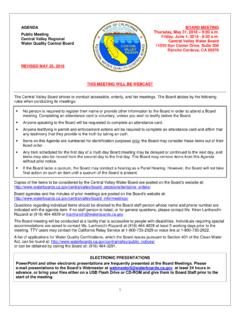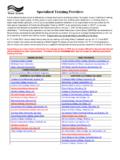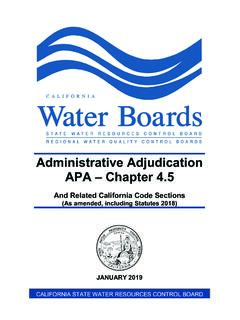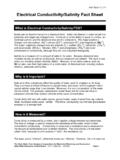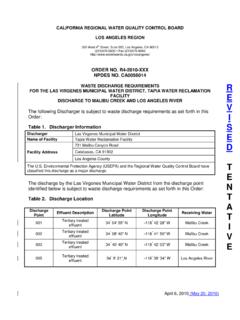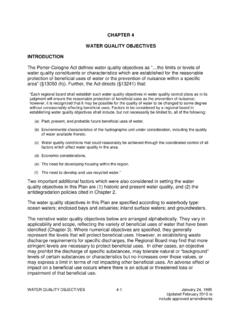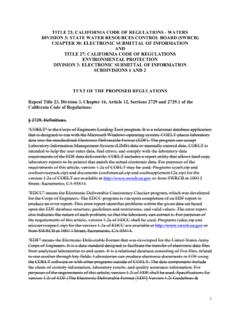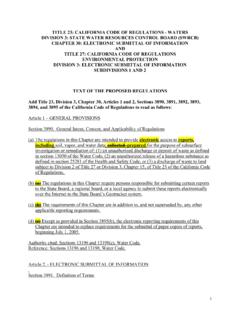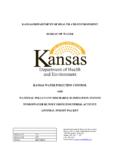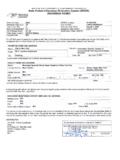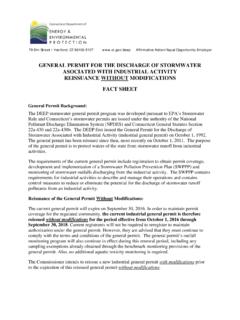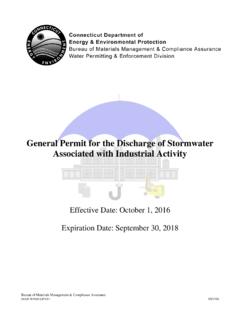Transcription of II. RATIONALE 7 - Home Page | California State …
1 State Water Resources Control Board Division of Water Quality 1001 I Street Sacramento, California 95814 (916) 341-5455 Mailing Address: Box 100 Sacramento, California 95812-0100 Fax (916) 341-5463 2009-0009-DWQ amended by 2010-0014-DWQ & 2012-0006-DWQ 1 Linda S. Adams Secretary for Environmental Protection Arnold SchwarzeneggerGovernor CONSTRUCTION GENERAL permit FACT SHEET TABLE OF CONTENTS I. BACKGROUND .. 1 A. History .. 1 B. Legal Challenges and Court Decisions .. 1 C. Blue Ribbon Panel of Experts and Feasibility of Numeric Effluent Limitations .. 4 D. Summary of Panel Findings on Construction Activities .. 4 E. How the Panel s Findings are Used in this General permit .. 5 F. Summary of Significant Changes in This General permit .
2 5 II. RATIONALE .. 7 A. General permit Approach .. 7 B. Construction Activities Covered .. 7 C. Construction Activities Not Covered .. 9 D. Obtaining and Terminating permit Coverage .. 12 E. Discharge Prohibitions .. 12 F. Effluent Standards for All Types of Discharges .. 13 G. Receiving Water Limitations .. 20 H. Training Qualifications and Requirements .. 20 I. Sampling, Monitoring, Reporting and Record Keeping .. 21 J. Risk Determination .. 27 K. ATS 35 L. Post-Construction Requirements .. 37 M. Storm Water Pollution Prevention Plans .. 46 N. Regional Water Board 48 2009-0009-DWQ amended by 2010-0014-DWQ & 2012-0006-DWQ 2 LIST OF TABLES Table 1 - Regional Water Board Basin Plans, Water Quality Objectives for Turbidity 16 Table 2 - Results of Ecoregion Analysis 16 Table 3 ACL Sampling Data taken by Regional Water Board Staff 17 Table 4 - Required Monitoring Elements for Risk Levels 21 Table 5 - Storm Water Effluent Monitoring Requirements by Risk Level 23 Table 6 - Receiving Water Monitoring Requirements 26 Table 7 - Combined Risk Level Matrix 29 Table 8 -National Oceanic and Atmospheric Administration (NOAA) Definition of Probability of Precipitation (PoP)
3 31 Table 9 - Qualified SWPPP Developer/ Qualified SWPPP Practitioner Certification Criteria 47 LIST OF FIGURES Figure 1 -Statewide Map of K * LS 28 Figure 2 - Suite of Storm Events 37 Figure 3 - Northern CA (2009) Counties / Cities With SUSMP-Plus Coverage 39 Figure 4 - Southern CA (2009) Counties / Cities With SUSMP-Plus Coverage 40 Figure 5 - Schematic of the Lane Relationship 42 Figure 6 - Channel Changes Associated with Urbanization 43 2009-0009-DWQ amended by 2010-0014-DWQ & 2012-0006-DWQ 1 I. BACKGROUND A. History In 1972, the Federal Water Pollution Control Act (also referred to as the Clean Water Act [CWA]) was amended to provide that the discharge of pollutants to waters of the United States from any point source is unlawful unless the discharge is in compliance with a National Pollutant Discharge Elimination System (NPDES) permit .
4 The 1987 amendments to the CWA added Section 402(p), which establishes a framework for regulating municipal and industrial storm water discharges under the NPDES Program. On November 16, 1990, the Environmental Protection Agency (USEPA) published final regulations that established storm water permit application requirements for specified categories of industries. The regulations provide that discharges of storm water to waters of the United States from construction projects that encompass five or more acres of soil disturbance are effectively prohibited unless the discharge is in compliance with an NPDES permit . Regulations (Phase II Rule) that became final on December 8, 1999 lowered the permitting threshold from five acres to one acre. While federal regulations allow two permitting options for storm water discharges (Individual Permits and General Permits), the State Water Board has elected to adopt only one statewide General permit at this time that will apply to most storm water discharges associated with construction activity.
5 On August 19, 1999, the State Water Board reissued the General Construction Storm Water permit (Water Quality Order 99-08-DWQ). On December 8, 1999 the State Water Board amended Order 99-08-DWQ to apply to sites as small as one acre. The General permit accompanying this fact sheet regulates storm water runoff from construction sites. Regulating many storm water discharges under one permit will greatly reduce the administrative burden associated with permitting individual storm water discharges. To obtain coverage under this General permit , dischargers shall electronically file the permit Registration Documents (PRDs), which includes a Notice of Intent (NOI), Storm Water Pollution Prevention Plan (SWPPP), and other compliance related documents required by this General permit and mail the appropriate permit fee to the State Water Board.
6 It is expected that as the storm water program develops, the Regional Water Quality Control Boards (Regional Water Boards) may issue General Permits or Individual Permits containing more specific permit provisions. When this occurs, this General permit will no longer regulate those dischargers. B. Legal Challenges and Court Decisions 1. Early Court Decisions Shortly after the passage of the CWA, the USEPA promulgated regulations exempting most storm water discharges from the NPDES permit requirements. (See 40 (1975); see also Natural Resources Defense Council v. Costle ( Cir. 1977) 568 1369, 1372 (Costle); Defenders of Wildlife v. Browner (9th Cir. 1999) 191 1159, 1163 (Defenders of Wildlife).) When environmental groups challenged this exemption in federal court, the District of Columbia Court of Appeals invalidated the regulation, holding that the USEPA does not have authority to exempt categories of point sources from the permit requirements of [CWA] 402.
7 (Costle, 568 at 1377.) The Costle court rejected the USEPA's argument that effluent-based storm sewer regulation was administratively infeasible because of the variable nature of storm water pollution and the number of affected storm sewers throughout the country. (Id. at 1377-82.) Although the court acknowledged the practical problems relating to storm sewer regulation, the court found the USEPA had the flexibility under the CWA to design regulations that would overcome these problems. (Id. at 1379-83.) In particular, the court pointed to general permits and permits based on requiring best management practices (BMPs). 2009-0009-DWQ amended by 2010-0014-DWQ & 2012-0006-DWQ 2 During the next 15 years, the USEPA made numerous attempts to reconcile the statutory requirement of point source regulation with the practical problem of regulating possibly millions of diverse point source discharges of storm water.
8 (See Defenders of Wildlife, 191 at 1163; see also Gallagher, Clean Water Act in Environmental Law Handbook (Sullivan, edit., 2003) p. 300 (Environmental Law Handbook); Eisen, Toward a Sustainable Urbanism: Lessons from Federal Regulation of Urban Storm Water Runoff (1995) 48 Wash. Urb. & Contemp. , 40-41 [Regulation of Urban Storm Water Runoff].) In 1987, Congress amended the CWA to require NPDES permits for storm water discharges. (See CWA 402(p), 33 1342(p); Defenders of Wildlife, 191 at 1163; Natural Resources Defense Council v. USEPA (9th Cir. 1992) 966 1292, 1296.) In these amendments, enacted as part of the Water Quality Act of 1987, Congress distinguished between industrial and municipal storm water discharges. With respect to industrial storm water discharges, Congress provided that NPDES permits "shall meet all applicable provisions of this section and section 1311 [requiring the USEPA to establish effluent limitations under specific timetables].
9 " (CWA 402(p)(3)(A), 33 1342(p)(3)(A); see also Defenders of Wildlife, 191 at 1163-64.) In 1990, USEPA adopted regulations specifying what activities were considered industrial and thus required discharges of storm water associated with those activities to obtain coverage under NPDES permits. (55 Fed. Reg. 47,990 (1990); 40 (b)(14).) Construction activities, deemed a subset of the industrial activities category, must also be regulated by an NPDES permit . (40 (b)(14)(x)). In 1999, USEPA issued regulations for Phase II of storm water regulation, which required most small construction sites (1-5 acres) to be regulated under the NPDES program. (64 Fed. Reg. 68,722; 40 (b)(15)(i).) 2. Court Decisions on Public Participation Two recent federal court opinions have vacated USEPA rules that denied meaningful public review of NPDES permit conditions.
10 On January 14, 2003, the Ninth Circuit Court of Appeals held that certain aspects of USEPA s Phase II regulations governing MS4s were invalid primarily because the general permit did not contain express requirements for public participation. (Environmental Defense Center v. USEPA (9th Cir. 2003) 344 832.) Specifically, the court determined that applications for general permit coverage (including the Notice of Intent (NOI) and Storm Water Management Program (SWMP)) must be made available to the public, the applications must be reviewed and determined to meet the applicable standard by the permitting authority before coverage commences, and there must be a process to accommodate public hearings. (Id. at 852-54.) Similarly, on February 28, 2005, the Second Circuit Court of Appeals held that the USEPA's confined animal feeding operation (CAFO) rule violated the CWA because it allowed dischargers to write their own nutrient management plans without public review.
